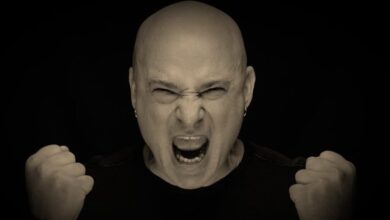Dio’s ‘Holy Diver’ Heralds Heavy-Metal Mythos and Mainstream Breakthrough in 1983
Released in May 1983, “Holy Diver” arrived like a thunderclap at a moment when heavy metal risked either ossifying into comfortable formulas or disappearing beneath the rising tide of slick pop and synth-driven new wave. Although the single itself only scraped the U.K. singles chart, peaking in the lower reaches, the album of the same name rode its momentum to Platinum certification in the United States and Top 20 status in the U.K., proving that a ferocious, fantasy-laden anthem could still carve space on mainstream airwaves and MTV rotations without diluting its molten-core intensity.
Ronnie James Dio’s path to that triumphant roar was anything but linear. Born in Portsmouth, New Hampshire, and raised in Cortland, New York, the singer honed his craft in bar bands during the early-1960s British-Invasion boom, eventually fronting the blues-psych outfit Elf. His leap to global notice came in the mid-1970s when Ritchie Blackmore tapped him for Rainbow, where Dio’s operatic tenor fused with neo-classical guitar to redefine hard-rock grandeur. A stint rescuing Black Sabbath from near-collapse followed, yet by 1982 Dio yearned for absolute creative control—thus the eponymous band Dio took shape, pairing his mythopoetic lyrics with guitarist Vivian Campbell’s razor-wire riffs.
Dio conceived “Holy Diver” after reading articles about missionaries who exploited impoverished regions while preaching salvation. Translating moral outrage into allegory, he cast a lone savior plunging into an oceanic abyss to rescue souls chained by ignorance—an image both biblically resonant and pagan in scope. Fans long speculated that the “tiger” and “shiny diamonds” referenced Christ and corrupted clergy, but Dio insisted the narrative was symbolic rather than doctrinal, inviting listeners to project their own battles with hypocrisy onto its vivid tableau.
Recorded at the newly built Sound City-adjacent Studio Sound in Los Angeles, the session captured the quartet—Dio, Campbell, bassist Jimmy Bain, and drummer Vinny Appice—playing almost entirely live in the room. Producer-engineer Angelo Arcuri, a veteran of Sabbath’s “Mob Rules,” emphasized a dry drum sound that foregrounded Appice’s tom-driven gallop while layering Campbell’s guitar in harmonized thirds, creating the illusion of a six-string phalanx charging behind Dio’s stentorian declarations. The singer’s vocal takes were famously first-or-second passes; years later engineers would still marvel at the lack of comping required.
Upon release, critics who previously dismissed metal as adolescent escapism applauded the track’s majestic synth-free ferocity and Dio’s literate lyrics. Although American pop radio remained wary, the video—complete with Dio wielding a chained flail against dungeon demons—earned heavy rotation on MTV, whose fledgling Headbangers Ball slot cemented the song as a generational calling card. In Britain, Kerrang! crowned it “Single of the Year,” while Japanese magazine Burrn! ranked it the decade’s finest metal composition, underscoring its worldwide resonance.
Culturally, “Holy Diver” reset the boundaries of metal storytelling. Where contemporaries leaned into dystopian science fiction or streetwise grit, Dio mined myth and medieval imagery to articulate real-world anxieties about corrupted authority. His lyrics encouraged listeners to view escapism and critique as two sides of the same sword, validating metalheads’ intellectual curiosity at a time when mainstream media painted them as lunkheaded rebels.
Careerwise, the song catapulted Dio from respected sideman to bona-fide arena headliner. Within a year he was selling out Madison Square Garden on the album’s tour, a feat few vocalists could claim after leaving two established giants. European festival promoters booked Dio atop bills that once seemed reserved for legacy acts, and Japan welcomed the band with a fervor not seen since Deep Purple’s early-1970s prime. The leap also granted Dio the leverage to champion young support acts, nurturing the next wave of metal talent.
Musically, “Holy Diver” crystallized the emerging melodic-metal template: galloping triplet rhythms, minor-key riff scaffolding, and soaring chorus hooks that invited communal fist-pumping without sacrificing darkness. Power-metal pioneers such as Helloween and Blind Guardian cite the track as blueprint, while thrash titans Metallica and Slayer acknowledged its influence on their sense of dramatic pacing—even as they took the genre in increasingly extreme directions.
Cover versions multiplied across stylistic borders. Pat Boone’s lounge-metal rendition on his 1997 “In a Metal Mood” album gave the song kitsch immortality, but Killswitch Engage’s 2006 metalcore take proved most consequential, re-introducing the anthem to a new generation and earning a Grammy nomination. Each interpretation underscored the composition’s elastic strength: transpose the key, shift the tempo, strip the symbology, and the core melody still barrels forward like a freight train.
Personally, 1983 was both zenith and crucible for Dio. While the single blazed up charts, he quietly cared for his then-wife Wendy as she managed his burgeoning business affairs amid intense touring pressure. Friends recall that the song’s plea to “ride the tiger” mirrored Ronnie’s own balancing act between artistic fire and human vulnerability—a duality that endeared him to fans and peers alike.
Decades later, “Holy Diver” remains a radio staple and perennial presence on “greatest metal songs” lists compiled by Rolling Stone, VH1, and Guitar World. Its transfixing main riff is a rite of passage for guitar students, and its chorus—equal parts exhortation and warning—still prompts mass sing-alongs from festival fields to sports arenas.
Beyond legacy playlists, the track’s production choices presaged the dry, upfront drum tones favored by 1990s alternative-metal bands and the layered vocal harmonies that symphonic-metal outfits would amplify with orchestras. Dio’s insistence on narrative-driven lyrics paved the way for conceptually ambitious acts such as Dream Theater and Mastodon, proving that metal could house literate, allegorical depth without surrendering brute power.
After Ronnie James Dio’s death from stomach cancer in 2010, global tribute concerts—from London’s High Voltage Festival to Los Angeles’ “Ride for Ronnie” events—centered their set lists on “Holy Diver,” underscoring its symbolic stature as both battle cry and elegy. The Recording Academy honored Dio posthumously with a Lifetime Achievement Award in 2017, citing the song as a milestone that “expanded the vocabulary of heavy music.”
Ultimately, “Holy Diver” endures because it channels timeless archetypes—heroism, sacrifice, corruption—through riffs that feel carved in granite and a melody that refuses to age. It is simultaneously a perfect snapshot of 1983’s metal renaissance and a piece that transcends its era, continuing to summon listeners into a realm where imagination and indignation march in lockstep. In fusing mythic narrative with arena-ready hooks, Dio didn’t merely deliver another head-banging anthem; he forged a sonic Excalibur whose blade still gleams across the modern musical landscape.





